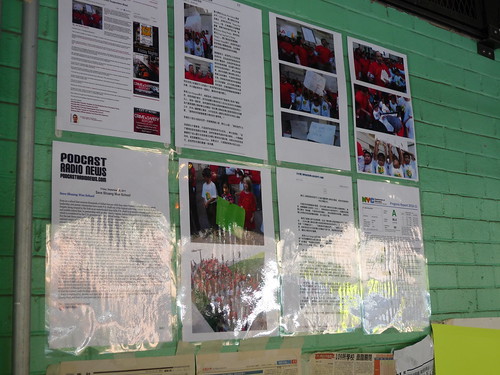New York—Even when the parents of PS 184 Shuang Wen School (SW) won the battle against the City Department of Education (DOE) back in 2009 to keep charter schools and traditional public schools from sharing buildings, they knew it was only a temporary truce.
As the size of the three existing charter schools in District One continue to grow and new charter school ideas are brewing, the DOE is now making new proposals for the co-location of new and existing charter schools with traditional public schools in the downtown school district. Although no specific school names have been announced yet, SW is again identified as a “underutilized school” that potentially would have to share space beginning next year. The news is making parents of the high performing public school angry and concerned, just like two years ago.
“I am not against the idea of a charter school, but I am against the way it was promoted by DOE,” said Joane Wong, mother of two SW students and activist of the parent-organized movement “Save Shuang Wen”. In Mrs. Wong’s eyes, the city DOE is constantly favoring the expansion of charter schools over the benefits of traditional public schools. “They (DOE) are spending all their energy trying to create space for charter schools,” Mrs. Wong added. “But for our school we are going to lose a science lab.”
If announced, the widely anticipated co-location proposal would further strain the relationship between the DOE and the parents of children enrolled at SW. In July, two parents of SW and a parent organization created by SW parents filed a lawsuit against the DOE. The lawsuit was triggered by the allegedly abusive investigatory practices against SW conducted by the DOE Office of Special Investigations. In an issued letter in response to the parents’ inquiries, DOE Chancellor Dennis Walcott stated that the department initiated the investigations on SW early this year on falsification of student records and three other related allegations. However, the parents accused the department of abusive treatment and suggesting it was a matter of discrimination, adding a racial element to the debate.
The ongoing investigations by DOE eventually led to the ousting of co-founder and former school Principal Ling Ling Chou, who is favored by many SW parents. The timing of the dismissal—only a few days after the lawsuit was filed—was deemed suspicious by many parents however. Mrs. Wong said she does not like to draw upon “conspiracy theory” when there is an adverse situation, but said it is hard to believe that dismissing Ling Ling Chou was not retaliation against the parents.
The controversy of the co-location case at SW focuses on whether the school is actually being underutilized. In the aftermath of the dismissal of Principal Chou, with the school now under a new management appointed by the DOE, enrollment of SW is below capacity for the first time in the past decade. Parents accused the new management of the school of manipulating the enrollment process and blocking many Asian students from enrolling, which resulted in 49 vacant seats.
“Why would you cut back and give opportunity to charter schools when you can help public school improve and grow?” asked Mrs. Wong. “From my perspective, DOE is intentionally creating these vacant seats so they can find places for charter schools”. The DOE, however, argued that the enrollment process was fair and helped maintain a student body with balanced racial percentages.
As the co-location debate rages in District 1, the issue has become a widespread topic across the city. Among the 136 charter schools in New York City, 78 are currently co-located with traditional public schools, according to Jaclyn Leffel, chief-staff of Office of Charter School under city DOE. At least a dozen of the co-location proposals, either before or after its implementation, encountered major resistance from school parents and community organizations, some resulting in lawsuits against the DOE.
“Kids would have less space,” said Arthur Schwartz, lead attorney in the litigation filed against the DOE by two parent-led organizations: NYC Parents Union and Class Size Matter. Speaking on behalf of the plantiffs, Mr. Schwartz said that co-location would inevitably reduce space for already struggling public schools. “They would have less library space, less physical education space, and less lunchroom space.”
However, the practice of charter schools increasingly sharing space with public schools is not very likely to go away, especially since the Bloomberg administration has put the expansion of charter schools as a priority. When asked whether co-location would become a long term strategy of DOE, Ms. Leffel, from Office of Charter School, responded affirmatively and confirmed that this initiative would continue while Mayor Bloomberg is in office.
One of the arguments of Bloomberg’s Administration for promoting charter schools is that the new concept would likely help break the rigid system of public education. Mr. Schwartz, the attorney representing parents’ organizations disagreed. He argued that charter schools would not help change the so-called “school bureaucracy” that many charter school advocates are critical of. “Charter schools would create a whole new level of school bureaucracy,” said Mr. Schwartz. “Besides, not everyone from Charter is putting the quality of education as their priority.”
Back at SW, there is likely to be more pressure on the school this time than there was two years ago because disgruntled parents seem to have lost many of their earlier allies already. Since the movement back in 2009 that helped keep charter schools from getting into district public schools, three more public schools, PS 142, PS 188 and PS 450, which were all involved in the movement two years ago, have started to share locations with charter schools, increasing uncertainty over SW’s future. Still, parents vowed to protect their children and the school, even if it meant fighting the same battle, again.
“There is going to be a big fight before anything happens,” said Joane Wong


